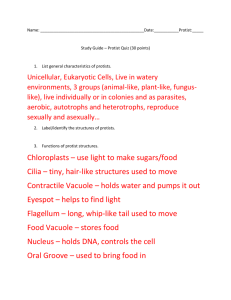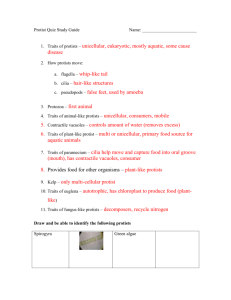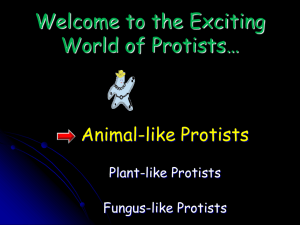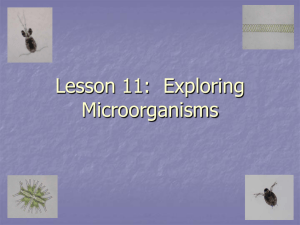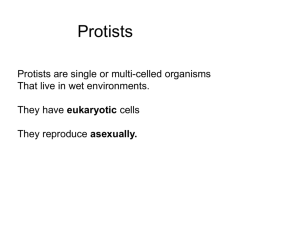protist
advertisement
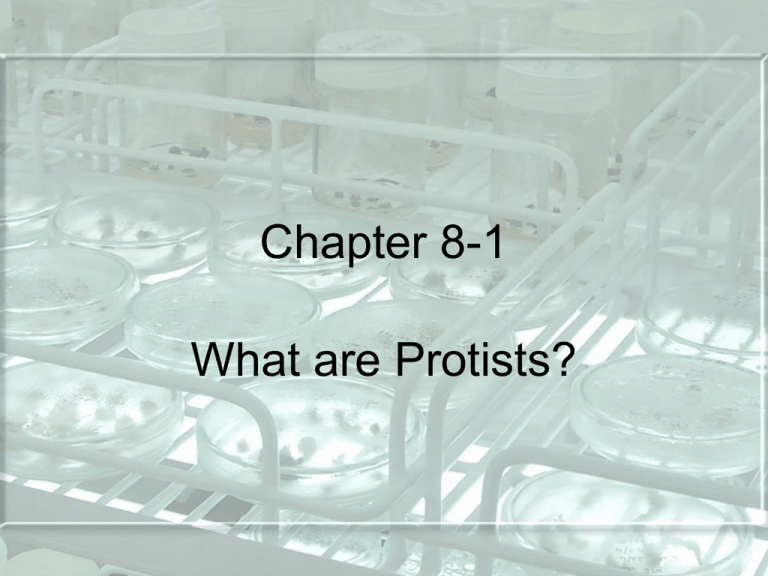
Chapter 8-1 What are Protists? What are Protists? –the “Junk Drawer” kingdom • A protist is a member of a group of eukaryotic organisms which have a membrane-bound nucleus. • Most protists reproduce asexually, though some can reproduce sexually • Protists are extremely diverse and share characteristics with plants, animals, and fungi but are not classified as any of these groups What are Protists? • General characteristics– Most are unicellular, but some, such as the giant kelp, are multicellular & can grow to be as big as 100 meters – Live in moist surroundings – Some move and some don’t – Some can make their own food, while others are consumers or decomposers – They are classified by how they obtain food • Scientists classify protists as plant-like, animal-like, or fungus-like based on which group they most resemble. Three kinds of Protists- • Plant-like • Animal-like • Fungus-like Plant-like Protists • Like plants, these protists use chlorophyll for photosynthesis – (takes place in chloroplasts) • Almost all live in water • Examples include: – – – – Algae Diatoms Dinoflagellates Euglenoids Plant-like Protists- Algae • Algae are plant-like protist that perform photosynthesis. They can be either multicellular or unicellular. • Red algae – Used to make ice cream, marshmallows & shampoo • Brown algae – Known as “seaweed” • Green algae Plant-like Protists- Diatoms • A type of microscopic plantlike protist with a hard outer wall is a diatom – Unicellular with glasslike cell walls – Used in silver polish, toothpaste & insulation Plant-like Protists- Dinoflagellates • Dinoflagellates are unicellular plantlike protists that use flagella to move. – They have many pigments so they come in several colors – They have 2 flagella that allow them to swirl around as they move – They glow in the dark & look like fireflies at night Plant-like Protists- Euglenoids • A Euglenoid is a unicellular plant-like protist that has a flagellum at one end of its body. It has no cell wall. Instead it has a rigid rubbery coat called a pellicle. • Euglenoids – Have eyespots that respond to changes in light • Tell the euglena when to perform photosynthesis – Produce food by photosynthesis Click on the image below to observe a Euglena swimming with it’s flagella The importance of Algae • Algae provide food for animals and animal-like protists, and provide shelter for many aquatic organisms such as sea otters. • They are plant-like but have holdfasts rather than roots. • Algae can help remove pollution from the water. Algae are thought to cause Red Tides •Pollution can be a food source for algae, allowing the population of algae to increase quickly. •This overproduction can lead to Red Tides, which can be dangerous to other aquatic animals & humans Animal-like Protists: Protozoans • Protozoans are protists that resemble tiny animals • Protozoans are unicellular and mostly live in wet environments. • Protozoans do not have chloroplasts and cannot make their own food. – They are consumers and some are parasites Animal-like Protists- Ciliates • Cilia are short, hair-like structures that grow on the surface of some protists. • Protists with cilia are called Ciliates. • Cilia cover the surface of the cell and move a protist through water. • Ciliates reproduce asexually, but they can exchange some genetic material through a process called conjugation. Animal-like Protists- Ciliates • A paramecium is a protist with cilia and two types of nuclei. • A paramecium gets its food by forcing water into the oral groove in its side. Click on the video below to observe a paramecium feeding! Animal-like Protists- Flagellate • A Flagellate is a type of protozoan with one or more flagella. • Flagellates eat decaying matter. Animal-like Protists- Sarcodines • Sarcodines are animal-like protists with no specific shape. • An amoeba is one common Sarcodine. • An amoeba moves and obtains nutrients by using pseudopods, which means temporary or false foot. • Amoeba form pseudopods by slowly pushing their cytoplasm against the soft, flexible cell membrane. Animal-like Protists: Protozoa cont’ • Amoeba use their pseudopods to engulf their food and form a food vacuole • They are found in soil, salt & fresh water, and use a contractile vacuole to get rid of excess water Click on picture below to observe an Amoeba in action!!! The Importance of Protozoans: Some protozoans are parasites and can cause disease like malaria. Animal-like Protists: Protozoa cont’ • Spore forming protist, Plasmodium Fungus-like Protists • Funguslike protists share many characteristics with fungi. • Slime molds are funguslike protists composed of cell material and nuclei floating in a slimy mass. • Most slime molds absorb nutrients from other organic matter in their environment. Funguslike Protists • A water mold is a funguslike protist that lives as a parasite or feeds on dead organisms. • Slime molds and water molds usually reproduce sexually when environmental conditions are harsh or unfavorable. Importance of Funguslike Protists • Funguslike protists play a valuable role in the ecosystem by breaking down dead plants and animals, making nutrients available for living organisms. • Many funguslike protists attack and consume living plants. • Water mold destroyed more than half of Ireland’s potato crop in 1845




